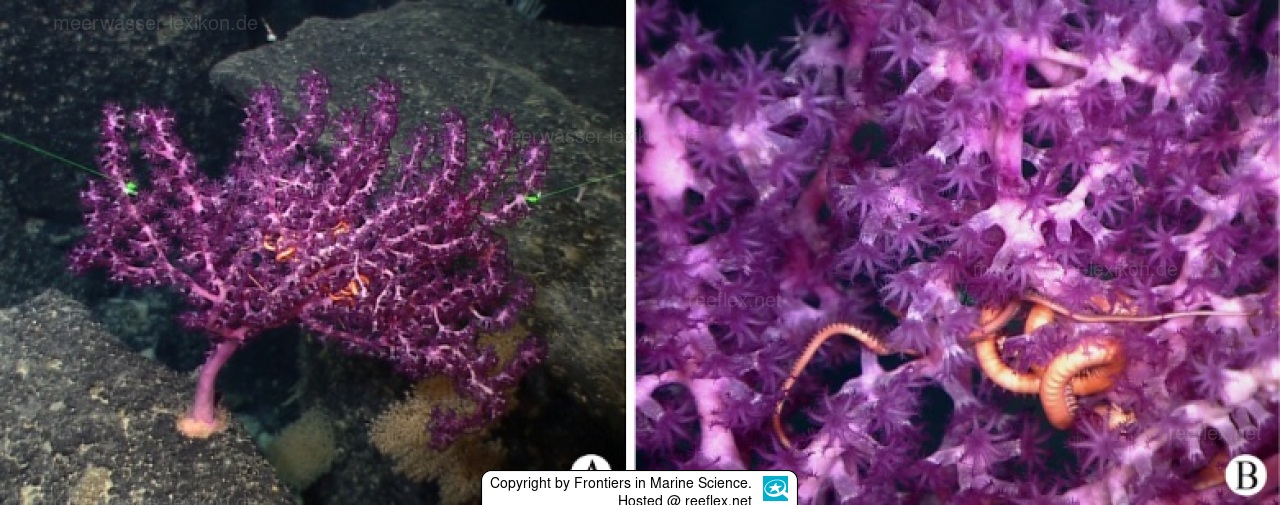Info
Several specimens of the deep-water gorgonian Victorgorgia eminens were found on a seamount (M6) on the Caroline Ridge in the tropical western Pacific Ocean, where water depths ranged from 813 - 890 meters, water temperatures ranged from 4.81° Celsius to 5.0°Celsius, and salinity was about 36.7 psu.
All colonies of the gorgonian were found on rocky bottoms, they were always inhabited by echinoderms of the order Euryalida.
Victorgorgia eminens is widely distributed from the southwestern Pacific to the tropical northwestern Pacific.
Colonies were multisided, dichotomous, specimen MBM286394 was 420 mm long and 265 mm wide, specimen MBM286392 was about 395 mm long and 236 mm wide.
The mounts of the colonies on the rock appeared almost circular, but was not collected with the colony.
The main stem is compressed, nearly rectangular in cross section, 14 mm wide, 23 mm deep, and about 100 mm long before the first branch emerges.
Terminal branches are 15 - 150 mm long and 2.2 - 3.5 mm in diameter, excluding the polyp tufts.
The polyp tufts usually contain 6 - 2 polyps and the tufts are 6-10 mm wide.
The colonies are covered with a thin cuticle. The medulla is separated from the cortex by a border space composed of anastomoses of border canals, around which some smaller indistinct canals sometimes appear.
The polyps are scattered around branches and arranged at right angles, their calyces distinct, usually clustered around the branches (specimen MBM286392) and often isolated around the branches of specimen MBM286394.
In preservation, the polyps are contractile and usually completely retracted into the calyxes in specimen MBM286394, and almost completely prominent in specimen MBM286392.
The polyp heads are usually 2.0 - 4.0 mm wide and up to 7.0 mm long in expanded specimens, the calyxes usually 3.0 - 5.0 mm wide and 2.0 - 3.5 mm long.
Each side of the tentacles is occupied by a row of about 7- 10 pinnules, the middle ones being the largest.
The polyps and coenenchyma are purple in vivo, freshly collected specimens are almost pink (specimen MBM286394) and reddish purple (specimen MBM286392).
All sclerites are transparent and colorless in transmitted light.
Etymology:
The species name "eminens" is derived from Latin and means 'outstanding'.
Literature reference:
www.frontiersin.org
Frontiers in Marine Science
Autoren: Yang li, Zifeng Zhan und Kuidong Xu1
Morphology and Molecular Phylogenetic Analysis of Deep-Sea Purple Gorgonians (Octocorallia: Victorgorgiidae) from Seamounts in the Tropical Western Pacific, with Description of Three New Species
All colonies of the gorgonian were found on rocky bottoms, they were always inhabited by echinoderms of the order Euryalida.
Victorgorgia eminens is widely distributed from the southwestern Pacific to the tropical northwestern Pacific.
Colonies were multisided, dichotomous, specimen MBM286394 was 420 mm long and 265 mm wide, specimen MBM286392 was about 395 mm long and 236 mm wide.
The mounts of the colonies on the rock appeared almost circular, but was not collected with the colony.
The main stem is compressed, nearly rectangular in cross section, 14 mm wide, 23 mm deep, and about 100 mm long before the first branch emerges.
Terminal branches are 15 - 150 mm long and 2.2 - 3.5 mm in diameter, excluding the polyp tufts.
The polyp tufts usually contain 6 - 2 polyps and the tufts are 6-10 mm wide.
The colonies are covered with a thin cuticle. The medulla is separated from the cortex by a border space composed of anastomoses of border canals, around which some smaller indistinct canals sometimes appear.
The polyps are scattered around branches and arranged at right angles, their calyces distinct, usually clustered around the branches (specimen MBM286392) and often isolated around the branches of specimen MBM286394.
In preservation, the polyps are contractile and usually completely retracted into the calyxes in specimen MBM286394, and almost completely prominent in specimen MBM286392.
The polyp heads are usually 2.0 - 4.0 mm wide and up to 7.0 mm long in expanded specimens, the calyxes usually 3.0 - 5.0 mm wide and 2.0 - 3.5 mm long.
Each side of the tentacles is occupied by a row of about 7- 10 pinnules, the middle ones being the largest.
The polyps and coenenchyma are purple in vivo, freshly collected specimens are almost pink (specimen MBM286394) and reddish purple (specimen MBM286392).
All sclerites are transparent and colorless in transmitted light.
Etymology:
The species name "eminens" is derived from Latin and means 'outstanding'.
Literature reference:
www.frontiersin.org
Frontiers in Marine Science
Autoren: Yang li, Zifeng Zhan und Kuidong Xu1
Morphology and Molecular Phylogenetic Analysis of Deep-Sea Purple Gorgonians (Octocorallia: Victorgorgiidae) from Seamounts in the Tropical Western Pacific, with Description of Three New Species







 Frontiers in Marine Science
Frontiers in Marine Science







